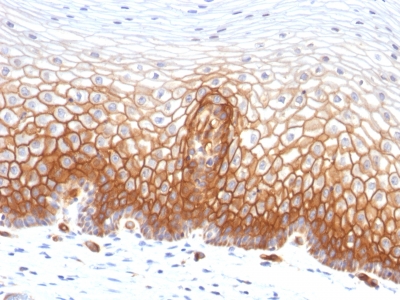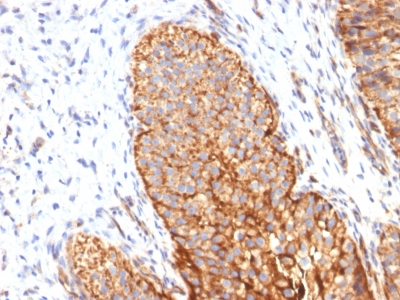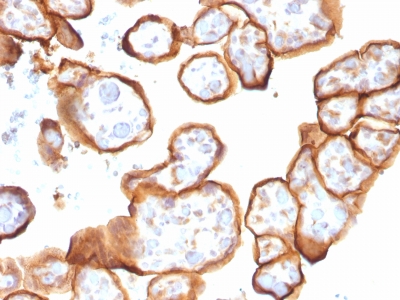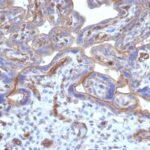Human Anti-Thrombomodulin / CD141 Antibody Product Attributes
Thrombomodulin / CD141 Previously Observed Antibody Staining Patterns
Observed Subcellular, Organelle Specific Staining Data:
Anti-THBD antibody staining is expected to be primarily localized to the cytosol and nucleoplasm.
Observed Antibody Staining Data By Tissue Type:
Variations in Thrombomodulin / CD141 antibody staining intensity in immunohistochemistry on tissue sections are present across different anatomical locations. Low, but measureable presence of Thrombomodulin / CD141 could be seen innon-germinal center cells in the lymph node and squamous epithelial cells in the tonsil. We were unable to detect Thrombomodulin / CD141 in other tissues. Disease states, inflammation, and other physiological changes can have a substantial impact on antibody staining patterns. These measurements were all taken in tissues deemed normal or from patients without known disease.
Observed Antibody Staining Data By Tissue Disease Status:
Tissues from cancer patients, for instance, have their own distinct pattern of Thrombomodulin / CD141 expression as measured by anti-Thrombomodulin / CD141 antibody immunohistochemical staining. The average level of expression by tumor is summarized in the table below. The variability row represents patient to patient variability in IHC staining.
| Sample Type | breast cancer | carcinoid | cervical cancer | colorectal cancer | endometrial cancer | glioma | head and neck cancer | liver cancer | lung cancer | lymphoma | melanoma | ovarian cancer | pancreatic cancer | prostate cancer | renal cancer | skin cancer | stomach cancer | testicular cancer | thyroid cancer | urothelial cancer |
|---|---|---|---|---|---|---|---|---|---|---|---|---|---|---|---|---|---|---|---|---|
| Signal Intensity | – | – | ++ | – | – | – | + | – | – | – | – | – | – | – | – | ++ | – | – | – | – |
| THBD Variability | ++ | ++ | ++ | + | + | + | ++ | + | + | + | + | + | + | ++ | + | ++ | + | + | + | ++ |
| Thrombomodulin / CD141 General Information | |
|---|---|
| Alternate Names | |
| Thrombomodulin, TM, CD141, BDCA-3 | |
| Molecular Weight | |
| 100kDa | |
| Chromosomal Location | |
| 20p11.2 | |
| Curated Database and Bioinformatic Data | |
| Gene Symbol | THBD |
| Entrez Gene ID | 7056 |
| Ensemble Gene ID | ENSG00000178726 |
| RefSeq Protein Accession(s) | NP_000352 |
| RefSeq mRNA Accession(s) | NM_000361 |
| RefSeq Genomic Accession(s) | NC_018931, NC_000020, NG_012027 |
| UniProt ID(s) | P07204 |
| UniGene ID(s) | P07204 |
| HGNC ID(s) | 11784 |
| Cosmic ID(s) | THBD |
| KEGG Gene ID(s) | hsa:7056 |
| PharmGKB ID(s) | PA36496 |
| General Description of Thrombomodulin / CD141. | |
| This MAb recognizes a protein of 75kDa, identified as Thrombomodulin. Thrombomodulin is a transmembrane glycoprotein with natural anticoagulant properties. It is normally expressed by a restricted number of cells, such as endothelial and mesothelial cells. In addition, synovial lining and syncytio-trophoblasts of placenta also express thrombomodulin. This protein is present in almost all of benign vascular tumors and majority of malignant vascular tumors (Kaposi s sarcoma, angiosarcoma, and epithelioid hemangioendothelioma). Hence, anti-thrombomodulin serves as a sensitive marker for lymphatic endothelial cells and their tumors. Recently, thrombomodulin antibody has been used for mesothelial cells and malignant mesotheliomas. | |







Reviews
There are no reviews yet.